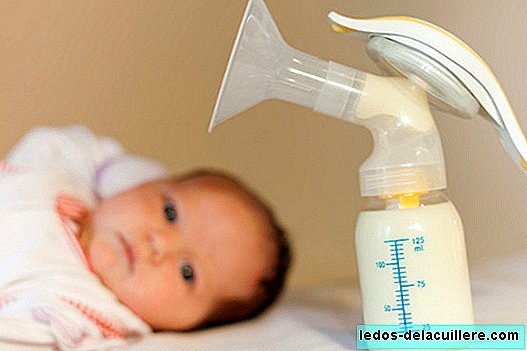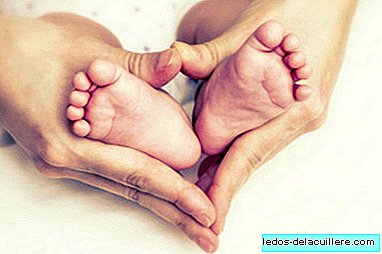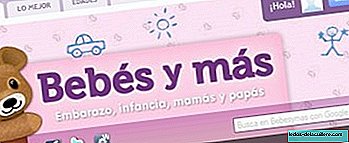September is not only time to return to school, but for many women who gave birth between April and June it is also time to join work after termination of maternity leave.
The labor incorporation it means for many mothers the end of breastfeeding: Many hours apart from their babies, doubts or bad advice can end a stage that both baby and mother would have wanted to continue maintaining. Therefore, today we want to offer you professional advice and real testimonials of mothers who demonstrate that breastfeeding can be maintained despite working away from home.
Only four out of ten babies maintain breastfeeding for up to six months
Approximately 100,000 babies throughout Spain will begin daycare throughout this month of September, after completing the maternity leave that will separate them from their mothers for several hours a day and with less than six months of life
Only four out of ten babies maintain exclusive breastfeeding until six months, as WHO recommends. And, for many mothers, the incorporation to work usually puts an end to exclusive breastfeeding.
Too many separate hours, bad advice, difficulties in making a milk bank, and doubts or lack of knowledge about breastfeeding leave are some of the causes that cause the abandonment of this stage.

We have spoken with the Multilacta Advisor, Almudena Gomis, who has told usI have given some tips to maintain breastfeeding despite having to join the work:
How to extract breast milk?
How to keep it ?,
How to proceed as long as we are separated from our baby?
But in addition to the professional advice of the lactation consultant, we wanted to know first hand the testimonies of Carol, Natalia and Blanca, three mothers managed to maintain their lactation while working outside the home.
Professional tips for extraction
Almudena advises that mothers who are going to return to work start making a milk bank a month before; in this way, they will not feel the burden of immediate incorporation and the extraction will be more effective.
The adviser advises to follow some simple guidelines that can help the creation of this bank:
Give yourself a chest massage before starting the extraction
Pull out Always at the same time so that the body gets used
Place one near photo of your baby or a video that helps raise oxytocin levels
If you choose to express the milk using a breast pump, choose the right funnel:
"Most breast pumps come with a funnel of size M by default, and not all women are served that size. Choose a size that fits correctly Our chest will not only prevent damage and problems in the extraction, but it will increase the amount of milk we can get "- recommends the advisor.
Almudena, alert us that at the beginning some mothers take very little milk and this demoralizes them. However, day after day and as we go to the technique of breast pump, we will increase the amount of each extraction.
Carol, Martin's mother, began to make a milk bank shortly after her son was born. His beginnings with breastfeeding were not good, but when he managed to overcome he decided not only to make his own bank, but also to become a donor to help other babies.

Once we have extracted the milk, it is important keep it properly in containers suitable for food. The consultant insists on this point, since otherwise, the plastic or material could eliminate toxins that contaminated breast milk.
"Personally I prefer to store breast milk in plastic bags suitable for this use, especially if we are going to freeze it. They take up little space and defrosting is very fast under hot water"- the adviser advises us, who is also the mother of three children and has experienced this process in the first person.
"Likewise, I advise store milk in small quantities of 50 or 60 ml so that nothing is wasted. It is better to offer the baby two bottles of 60 ml that, at first one of 120 ml that is likely not to be taken whole and that you have to throw it away. Because when the milk has come into contact with the baby's mouth and saliva through the nipple of the bottle, it can no longer be stored again "
He proper milk storage It is something we have talked about on occasion, and it may vary depending on the time of year we are in. Stored in a refrigerator, the milk can last several days while if we choose to freeze it, our baby can consume it even several months later (always depending on the type of freezer we have and the temperature it reaches).
Advice from the consultant to combine breastfeeding and work
Once we know how to make a milk bank, many mothers wonder if their babies they will gladly accept the bottle when they are not. Almudena tells us that there are usually no rejection problems, but recommends doing a test before if this will reassure the mother.
"It is important that the test bottle is not given from the mother to the baby, but the father or any other relative. If the baby smells like the mother, he will reject the bottle because what he wants is his mother's breast"
However, it is not always easy and sometimes we can meet babies who reject bottle nipples and they refuse to eat until their mother does not meet them again. These cases usually generate great stress for mothers although, normally, this stage is temporary.
Blanca, Cecilia's mother, joined work after 16 weeks of maternity leave and lived in anguish how her baby did not accept the bottle in her absence:
"Despite having made a milk bank weeks before joining work, my daughter refused to eat in my absence. I cried a lot and did not accept the pacifier. So we spent two months until we started with complementary feeding, and the introduction of fruits in the diet made the situation more bearable"
A similar process lived Carol. His baby, Martin, who was only five months old when he went to daycare for the first time, did not want to take a bottle in his absence:
"When I picked up my son from the nursery, I sat with him on a bench that was right in front and the first thing I did was to breastfeed. The poor man pounced like a madman and spent the afternoon stuck to me, recovering time lost"
For Natalia, however, Lucia and María's mother, the incorporation to work was not a problem when offering her bottle milk:
"In both cases, my daughters were five months old when I joined work. With the oldest, it was Dad who was in charge of giving the bottle and the little one was given it in the nursery school. At first, it was difficult for me to get the breast pump but when I took the trick I drank the milk at work and returned home with my portable little book full of reserves "
 The consultant advises us to offer the baby the last shot immediately before separating from him and that this is the first thing we do as soon as we meet again
The consultant advises us to offer the baby the last shot immediately before separating from him and that this is the first thing we do as soon as we meet againDepending on the duration of the mother's workday, we will have to resort to one, two or even more shots of bottle with breast milk, but when the complementary feeding begins, we can play with the introduction of new foods, textures and flavors without the need to replace shots of breast milk.
How to get milk at work?
Before joining the job, it is important that the mother knows her legal rights to enjoy the breastfeeding permit in the way that best suits her. Once this point is clarified, and in case you have decided pumping milk at work, you must locate a place where you can do it comfortably and quietly, and do not forget the breast pump and a portable fridge for storage.
 The adviser advises that whenever possible, the mother withdraws milk at work, to continue maintaining the same rate of production and, at the same time, continue to increase her milk bank
The adviser advises that whenever possible, the mother withdraws milk at work, to continue maintaining the same rate of production and, at the same time, continue to increase her milk bank"Once the milk is extracted, it can be stored in a portable refrigerator with two or three ice accumulators. If we have our baby in the nursery, we can leave the milk there when we go to look for him, so they will have it for the next day. Another option is to take it home and store it in our refrigerator or freeze it "- he explains.
But, sad as it may be, Not all companies make this task easier for their workers. Blanca's case is a clear example of this:
"It didn't seem good to my boss that I was absent half an hour to get the milk. But It was my right and I strictly fulfilled my schedule to be able to extract myself. He did not have a room equipped for it and he had to do it in the bathroom "- he laments.
Carol, on the other hand, lived a very different situation and He had the support of his company, facilitating the moment of being absent to express the milk and even providing a room for it.
"Next to my office was a trusted bar where I kept the refrigerated milk until I went home. I had a lot of support as well as good lactation consultants who accompanied me along the way. My son is now over three years old and he still has his tit, and he doesn't want to quit! " - He shares us excitedly.
These three mothers feel tremendously proud of have maintained breastfeeding despite labor incorporation. With more or less obstacles, the three managed to breastfeed their children beyond 16 weeks of low, maintain exclusive breastfeeding for six months and later, much longer.
"Despite the difficulties I went through, I would do it again with my eyes closed. It is the most wonderful experience that motherhood has brought me" - affirms Blanca convinced.
Therefore, if you want to continue maintaining your breastfeeding despite joining work, don't let this fact stop you. Seek professional support if you need it, and surround yourself with good advice and experiences. You and your baby will thank you. Happy return to work to all mothers!












